

The CAUSES of RAINFOREST DESTRUCTION. Return to Education Supplement ContentsRainforest Information Centre Educational Supplement The CAUSES of RAINFOREST DESTRUCTION The following issues are discussed: 1.
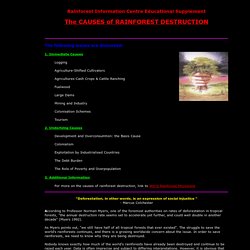
Immediate Causes Logging Agriculture-Shifted Cultivators Agricultures-Cash Crops & Cattle Ranching Fuelwood Large Dams Mining and Industry Colonisation Schemes Tourism 2. Underlying Causes. Why are rainforests being destroyed? Saving the Rainforest. How Humans Affect Animals. There are millions of insects, fish, amphibians, reptiles, birds and mammals, but only one kind of human.

Human can do good things for animals: help save endangered species by breeding more animals and saving their environment; making sick animals healthy, and caring for animals who can no longer live in the wild. Humans can also cause harm to animals, on purpose or by accident. Habitat Destruction When humans destroy wild land to build homes, factories, shopping malls, amusement parks, garbage dumps, even to build a visitor center, store and restaurant in a park, the land is changed. The animals that once lived there, from the bugs that lived in the ground to the birds that ate them, all may disappear. Some can move to new home areas, but there are already other animals living there.
When farmers spray chemicals on their crops to save them from pests (bugs and molds and things that eat the plants), the chemicals get into the water and into the soil. Rainforest Destruction. What can you do to help save the rainforest?
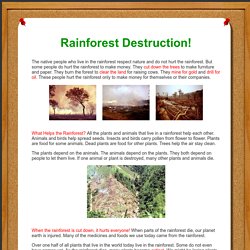
Use less paper to help save the rainforest! Paper is made from trees. If you use less paper, fewer trees will be cut down. Using less paper is easy. Use less gasoline and plastic. Instead of buying plastic, choose glass containers whenever possible. Eat less red meat. National Geographic. In Brazil, which houses 30 percent of the remaining tropical rain forest on Earth, more than 50,000 square miles of rain forest were lost to deforestation between 2000 and 2005.

Biologists worry about the long-term consequences. Drought may be one. Forests: Threats to our forests. Deforestation Results of deforestation Forests are cleared all around the world for a number of reasons, including: Harvesting of timber to produce wood and paper products Clearing land for farms, cash-crop plantations, and cattle ranching Clearing land for urban development, including homes and roads.
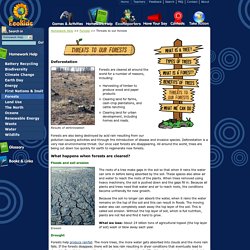
Forests are also being destroyed by acid rain resulting from our pollution-causing activities and through the introduction of disease and invasive species. Deforestation is a very real environmental threat. Deforestation. Deforestation, clearance or clearing is the removal of a forest or stand of trees where the land is thereafter converted to a non-forest use.[1] Examples of deforestation include conversion of forestland to farms, ranches, or urban use.

Deforestation occurs for many reasons: trees are cut down to be used or sold as fuel (sometimes in the form of charcoal) or timber, while cleared land is used as pasture for livestock, plantations of commodities and settlements. The removal of trees without sufficient reforestation has resulted in damage to habitat, biodiversity loss and aridity. It has adverse impacts on biosequestration of atmospheric carbon dioxide. Deforestation has also been used in war to deprive the enemy of cover for its forces and also vital resources. Modern examples of this were the use of Agent Orange by the British military in Malaya during the Malayan Emergency and the United States military in Vietnam during the Vietnam War. Causes Environmental problems Atmospheric. Endangered Animals List. Animal endangerment is a big environmental issue, and the number of endangered animals is constantly on the rise.
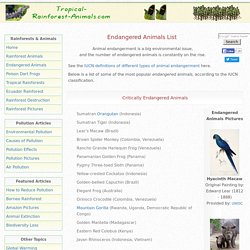
Deforestation Facts, Deforestation Information, Effects of Deforestation. Modern-Day Plague.

Rain Forest Threats, Rain Forest Species. More than half of Earth’s rain forests have already been lost forever to the insatiable human demand for wood and arable land.

Rain forests that once grew over 14 percent of the land on Earth now cover only about 6 percent. And if current deforestation rates continue, these critical habitats could disappear from the planet completely within the next hundred years. The reasons for plundering rain forests are mainly economic. Wealthy nations drive demand for tropical timber, and cash-strapped governments often grant logging concessions at a fraction of the land’s true value. “Homesteader” policies also encourage citizens to clear-cut forests for farms. Threats Solutions. Rainforest Concern - What can we do to stop deforestation? There are lots of other things you can do that will make a difference to the world’s rainforests, as well as your local environment.
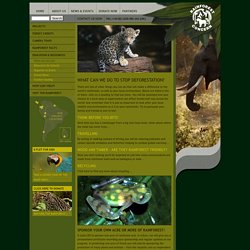
Below are listed a few of them: click on a heading to find out more. You will be surprised how your choices in a local shop or supermarket can affect forests half way across the world! And remember that it is just as important to look after your local wildlife and environment as it is to save rainforests. Try to persuade your family and friends to join in too! Next time you buy a hamburger from a big fast food chain, think about where the meat has come from... Travelling By cycling or walking instead of driving you will be reducing pollution and carbon dioxide emissions and therefore helping to combat global warming... Environmental issue. Environmental issues are harmful effects of human activitity on the biophysical environment. Environmentalism, a social and environmental movement, addresses environmental issues through advocacy, education and activism. The carbon dioxide equivalent of greenhouse gases (GHG) in the atmosphere has already exceeded 400 parts per million (NOAA) (with total "long-term" GHG exceeding 455 parts per million).
(Intergovernmental Panel on Climate Change Report) This level is considered a tipping point. "The amount of greenhouse gas in the atmosphere is already above the threshold that can potentially cause dangerous climate change. We are already at risk...It's not next year or next decade, it's now. " "Climate disasters are on the rise. Types[edit] Major current environmental issues may include climate change, pollution, environmental degradation, and resource depletion etc. Scientific grounding[edit] Organizations[edit] Solutions[edit]